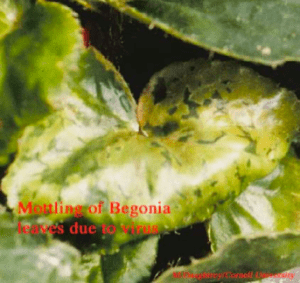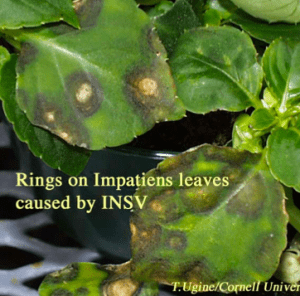Viruses are submicroscopic infectious agents that generally consist of particles composed of protein surrounding genetic material (RNA or DNA). Because plants do not produce antibodies, they neither recover from a virus infection nor become immune. Once a plant is infected, it may remain infected for life, even though the symptoms of disease become masked or the plants grow out of it under certain conditions. Thus perennial plants and vegetatively propagated greenhouse plants carry the virus from one crop to the next with continuing loss to the disease.
Currently, impatiens necrotic spot virus (INSV), previously called TSWV-I, is the most common and most damaging virus in the greenhouse industry. The virus has an extremely broad host range, and its insect vector, the western flower thrips, is widespread and hard to control. Tomato spotted wilt virus (TSWV) is also vectored by these thrips. For control suggestions, see the bedding plant fact sheets, “Diseases of Specific Florist Crops” and the descriptions given under the sections covering diseases of African violet, begonia, calceolaria, chrysanthemum, cyclamen, and gloxinia. INSV is also a problem on foliage plants as well as most crops other than roses and poinsettia. Geraniums have only rarely shown symptoms of the disease. Tuberous dahlias and chrysanthemums are susceptible to both INSV and TSWV.
Symptoms
The most common symptom of virus infection is stunting or dwarfing. Leaves may also show distinctive signs, most commonly color changes. Leaves may show spots, streaks, blotches, and rings of light green, yellow, white, brown, or black, or they may develop uniform yellow or orange coloration. Leaves also may change in size or shape, either puckering or developing rolled margins. Flowers may be dwarfed, deformed, streaked, faded, colored green instead of their usual color, or even changed into leafy structures. These are only a few of the more obvious symptoms caused by virus or viruslike causal agents.
Spread
Generally, viruses are not transmitted through seed with the exception of tomato ring spot and tobacco ring spot, which affect geraniums. A bedding plant crop grown from seed can suffer serious loss if a virus disease (e.g., TSWV) is introduced by an insect vector and has an efficient means of spread. The next year, however, the crop will again start clean.
Although viruses can spread unaided from cell to cell in one plant, they require active assistance to spread from one growing plant to another as well as a wound through which to enter the plant. Most frequently, viruses are spread by insects feeding on a healthy plant after feeding on an infected one, by grafting with a scion from an infected plant, or by using infected stock plants as a source of cuttings.
Insect control can be critical to virus control in greenhouses. The current difficulty in controlling western flower thrips, for example, creates a potential danger of widespread INSV infections.
Indexing Program
The use of pathogen-free propagating material is extremely important in any disease control program. Virus indexing is used to eliminate viral pathogens from propagative material of chrysanthemums, carnations, geraniums, orchids, lilies, hydrangeas, and foliage plants. Culture- and virus-indexed material is initially free of the internal pathogens for which the index is set up to check; such plant material is not disease resistant, however, and requires a growing medium free of the designated pathogens and good cultural practices if the full potential of healthy plants is to be realized.
Virus indexing makes use of indicator plants or serological assays for each specific virus because many cultivars can act as “sleepers,” that is, virus carriers that show no external symptoms. Sleeper varieties or cultivars are a tremendous threat because they can be responsible for a large amount of virus spread before the grower realizes there is a serious problem. When the plants are about to flower, the seriousness of the problem is realized in uneven plant growth and flowering time along with a reduction in flower quality.
Diseases of a few crops for which indexing programs have been developed are listed below.
Chrysanthemum
Viruses
- Chrysanthemum stunt
- Chrysanthemum mosaics
- Chrysanthemum aspermy
- Chrysanthemum chlorotic mottle
Vascular wilts
- Verticillium wilt
- Bacterial blight
- Bacterial wilt
- Slow wilt
Carnation
Viruses
- Carnation mottle
- Carnation ring spot
- Carnation mosaic
- Carnation streak
- Tomato spotted wilt
- Carnation etch-ring
- Necrotic fleck
Vascular wilts
- Fusarium wilt
- Phialophora wilt
- Bacterial wilt
Geranium
Viruses
- Tomato ring spot
- Tobacco ring spot
- Pelargonium flower break
Vascular wilts
- Bacterial blight
- Verticillium wilt





